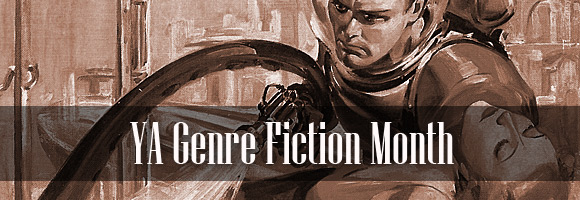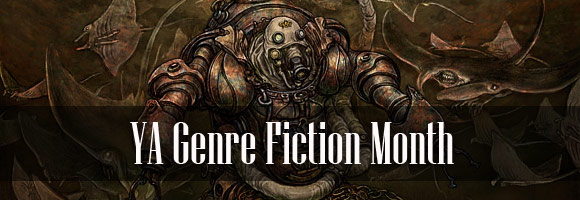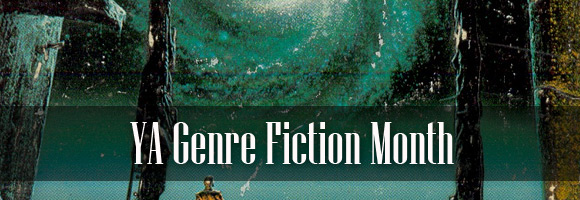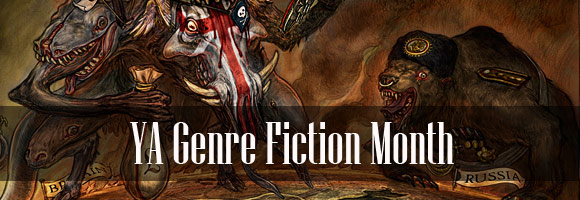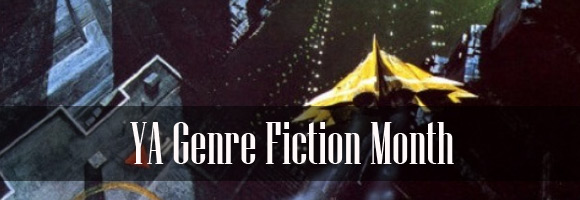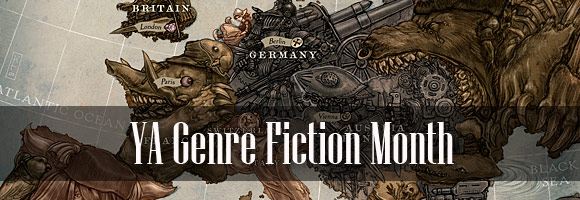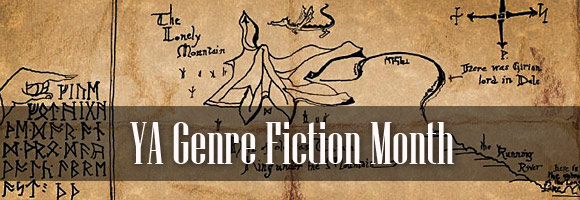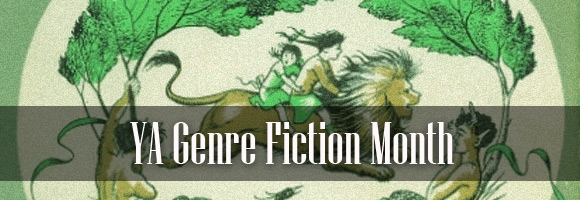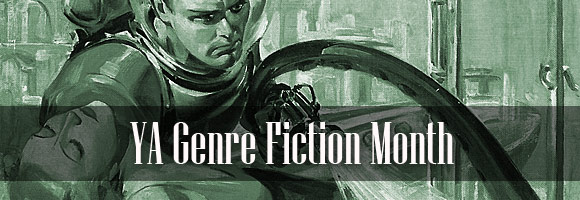YA Genre Fiction Month: End of Month Wrap-Up
“If you go back even 15 years there was definitely a tendency at that point to go from kids’ books to adult books. The idea that people would be writing books aimed primarily at a teen audience is really cool and really new, and the idea of YA books being genre books is, again, cool and new.” –Neil Gaiman (from the Spinoff Online blog)
 The young adult literature movement is a newcomer in the history of literature, and only time will tell if it is one that will remain a permanent fixture into the future. While its popularity is certainly on the rise, as the shelf-space allotment in any bookstore will prove, is YA a movement with legs or is it just a fad? Even Wikipedia can’t solidly trace its history earlier than the twentieth century.
The young adult literature movement is a newcomer in the history of literature, and only time will tell if it is one that will remain a permanent fixture into the future. While its popularity is certainly on the rise, as the shelf-space allotment in any bookstore will prove, is YA a movement with legs or is it just a fad? Even Wikipedia can’t solidly trace its history earlier than the twentieth century.
I expect that the popularity of art aimed at young adults depends a great deal on how much the adolescent generation identifies itself with older generations, how strongly it either looks forward to assimilation into the world of adulthood or else seeks to form its own separate identity. Our time seems to be clearly one where the young desires separation more than assimilation, today as much as the revolutionary sixties. They want their own music, their own television programs, and their own fiction.
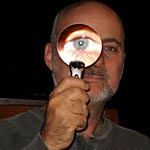 As with any youth-driven movement, YA fiction is full of energy, expectation and anxiety: Ender’s Game exposes the often confusing and unfair relationship between children and adults, The Hobbit encourages even “little people” to be open to the call to adventure, and Harry Potter is a study of what happens to children of whom much is expected but who receive far too little support from their elders. Much of YA fiction is straight-up adventure fiction written at the appropriate age-level, often enough with adult protagonists. It’s becoming more popular, however, to populate YA books with young adult characters—an inevitable evolution, I suppose. The fictional dream becomes stronger the more the reader is able to identify with its characters. The books nominated in the Locus YA Award bear out this observation, and that list contrasts quite sharply with David Brin’s list of books with mostly-adult protagonists.
As with any youth-driven movement, YA fiction is full of energy, expectation and anxiety: Ender’s Game exposes the often confusing and unfair relationship between children and adults, The Hobbit encourages even “little people” to be open to the call to adventure, and Harry Potter is a study of what happens to children of whom much is expected but who receive far too little support from their elders. Much of YA fiction is straight-up adventure fiction written at the appropriate age-level, often enough with adult protagonists. It’s becoming more popular, however, to populate YA books with young adult characters—an inevitable evolution, I suppose. The fictional dream becomes stronger the more the reader is able to identify with its characters. The books nominated in the Locus YA Award bear out this observation, and that list contrasts quite sharply with David Brin’s list of books with mostly-adult protagonists.
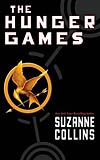 What does the future hold for the young adult literature movement? The almost absurd popularity of book series like Stephenie Meyer’s Twilight and Suzanne Collins’ The Hunger Games ensures, at the very least, a continued exploitation of this market until trends move in some other direction. The existence of a YA market, though, is not (I think) as stable or certain as the children’s and adult markets. I expect it to remain popular for decades to come, but only time will tell.
What does the future hold for the young adult literature movement? The almost absurd popularity of book series like Stephenie Meyer’s Twilight and Suzanne Collins’ The Hunger Games ensures, at the very least, a continued exploitation of this market until trends move in some other direction. The existence of a YA market, though, is not (I think) as stable or certain as the children’s and adult markets. I expect it to remain popular for decades to come, but only time will tell.
YA Genre Fiction Month: Goliath
Guest Blogger, Allie McCarn, reviews science fiction and fantasy books on her blog Tethyan Books which we featured in a previous post: Five SF/F Book Blogs Worth Reading. She has already contributed many great book reviews to WWEnd and has generously volunteered to write some periodic reviews for our blog. Be sure to check out her site and let her know you found her here.
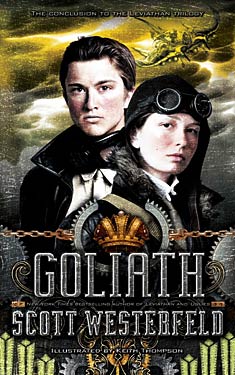 Goliath by Scott Westerfeld
Goliath by Scott Westerfeld
Published: Simon Pulse, 2011
Series: Leviathan Series: Book 3
**Spoiler Alert: I’ve been trying to keep clear of spoiling plot points, but, given that this novel has only been out for a couple of months, it might be a good idea to stop here if you don’t want to be spoiled.
The Book:
"Alek and Deryn may have helped resolve the situation with the Ottoman Empire, but World War I is still escalating. Alek is determined that it is his destiny to end the war, since it was his parents’ deaths started it. However, he’s stuck aboard the Leviathan, which is heading further and further from the heart of the conflict, for reasons no one seems inclined to explain to him.
Deryn’s secret—that she is a woman—is getting harder to keep, particularly now that she has fallen in love with her best friend Alek. She feels certain they could never be together, since he’s the heir to the Austro-Hungarian Empire and she’s a cross-dressing soldier. What she doesn’t know is how Alek will react if he ever learns the truth.
As the course of the Leviathan is diverted through Siberia, Japan, Mexico, and finally to New York City, Deryn and Alek will encounter new dangers, new people, and new hopes for an end to the war!” ~Allie
This is my final review for WWend’s YA Genre Fiction Month. Once again, Goliath picks up right where Behemoth left off, and the first two novels are necessary reading before picking this one up. In most series, I can pick out the stronger and weaker installments, but the novels in the Leviathan trilogy are of remarkably consistent quality. Westerfeld has crafted an even, continuously exciting trilogy that has now come to a very satisfying conclusion.
My Thoughts:
As in the case of the previous two volumes, Goliath is packed with many of Keith Thompson’s wonderful illustrations like the header image above. These are particularly good for showing off the many creative steam-powered machines and fabricated animals that Deryn and Alek encounter on their travels. This time around, the Leviathan airship journeys through many exotic locations, though none of them are nearly as fleshed out as Westerfeld’s Istanbul. While there’s still plenty of action, this is more of a character-oriented book than the previous two. It feels as though it is more focused on Alek and Deryn’s personal stories, though they are still caught up in dramatic historical events.
Aside from the continuing cast aboard the Leviathan, a handful of characters from earlier in the story also make appearances in Goliath. The ‘perspicacious lorises’ from Behemoth are still around, and I feel like I can comment on their role in the story now. While the lorises are quite adorable, in pictures and in actions, they seem to exist solely to point out important clues to the characters (and readers). Considering they were Dr. Barlow’s life work, I had hoped that there would be something more to them. The size of the novel’s cast also swells from the addition of many new characters, some of which are based on historical figures. Though it’s neat to see fictional representations of well-known people from history, I was a little concerned by the strong negative characterization of a certain famously eccentric scientist. I hope that younger readers will understand that while these characters are based on real people, a fair amount of artistic liberty is taken in their portrayal.
I think Goliath handles the budding romance between Deryn and Alek much more skillfully than the previous volume. The original ‘falling in love’ of Deryn seemed abrupt, but the development of their relationship seemed much more natural in Goliath. Deryn’s constant angsting about her and Alek’s relative social status got a little old, but I can’t claim that her obsessing isn’t realistic for someone caught in the grips of first love. I think the story involving Deryn’s secret gender stretched credulity a bit, but I was mostly willing to just go along with the ride. While their romance took a much larger role in this novel, there’s still quite a bit more to the story. Throughout their adventures, I enjoyed watching Alek and Deryn try to make sense of the chaotic world and their places in it.
I’m not aware of any way of connecting Thomas Hobbes to the title Goliath, so I’m going a little further back in time with this title. The obvious reference is to the biblical story of David and Goliath. However, I think Goliath has more to say than the usual statements about a small hero defeating a giant enemy through faith and intelligence. I think Goliath was intended to provoke discussions about morality of the David/Goliath situation. If it will end a war, is it moral to kill someone, as David did Goliath? If by violence, or threat of violence, you can protect the people you love and bring about peace, does that make your actions acceptable? Westerfeld does not provide a simple answer, but these are interesting questions to discuss against the events of Goliath.
My Rating: 4/5:
Goliath is consistent with the high level of quality I have come to expect from Scott Westerfeld’s young adult novels. Deryn and Alek continue their adventures on the Leviathan, traveling to new and exciting locations. Many characters, new and old, show up along the way, and some of them are based on actual people. Goliath deals both with the small-scale story of Deryn and Alek’s personal troubles and secrets, and the large-scale story of attempting to end World War I. I was pleased that Westerfeld did not choose, in the end, to give his readers an unrealistically happy ending. Overall, I think this was a highly satisfying conclusion to the Leviathan trilogy.
YA Genre Fiction Month: Foundation
“There were nearly twenty-five million inhabited planets in the Galaxy then, and not one but owed allegiance to the Empire whose seat was on Trantor. It was the last half-century in which that could be said.”
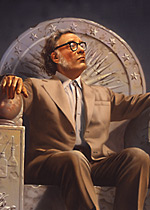 Isaac Asimov’s Foundation series is magnificently ambitious, inspired as it was by Gibbon’s Decline and Fall of the Roman Empire, but painted on a galactic canvas. After twelve thousand years in the stars, the human Galactic Empire is on the decline, and the psychohistorian Hari Seldon may be the only person who can prevent tens of thousands of years of barbarism and social decay. What’s psychohistory, you ask? It’s a science that Asimov invented solely for use in this series, one that merges psychology, history and mathematics to predict human behavior on a large scale over long periods of time.
Isaac Asimov’s Foundation series is magnificently ambitious, inspired as it was by Gibbon’s Decline and Fall of the Roman Empire, but painted on a galactic canvas. After twelve thousand years in the stars, the human Galactic Empire is on the decline, and the psychohistorian Hari Seldon may be the only person who can prevent tens of thousands of years of barbarism and social decay. What’s psychohistory, you ask? It’s a science that Asimov invented solely for use in this series, one that merges psychology, history and mathematics to predict human behavior on a large scale over long periods of time.
Seldon paints a bleak picture of the coming imperial collapse: “The Empire will vanish and all its good with it. Its accumulated knowledge will decay and the order it has imposed will vanish. Interstellar wars will be endless; interstellar trade will decay; population will decline; worlds will lose touch with the main body of the Galaxy. And so matters will remain…. The dark ages to come will endure not twelve, but thirty thousand years.” This collapse, Seldon says, cannot be prevented, but its effects can be minimized and its length shortened to a mere one thousand years.
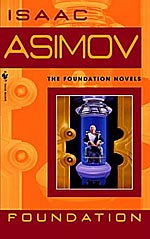 His solution is to set up two Foundations, colonies where the collected knowledge and science of mankind is preserved and protected, one on each end of the galaxy. The Foundation established on the planet Terminus is the one followed by the narrative, and it has no contact with the other. Every few decades a “Seldon Crisis”—an event of massive social upheaval—occurs in a way predicted by Seldon, and Terminus acts how Seldon needed them to act in order to maintain his plan.
His solution is to set up two Foundations, colonies where the collected knowledge and science of mankind is preserved and protected, one on each end of the galaxy. The Foundation established on the planet Terminus is the one followed by the narrative, and it has no contact with the other. Every few decades a “Seldon Crisis”—an event of massive social upheaval—occurs in a way predicted by Seldon, and Terminus acts how Seldon needed them to act in order to maintain his plan.
One of the most difficult subjects for me as a young adult was history, particularly because it was so hard to find meaningful patterns in the larger scope of world events. It’s not hard to poke holes in Gibbon’s theories of history, but he certainly provided a rousing narrative that made sense of many historical data. Asimov likewise provides a narrative spanning centuries (actually, twenty thousand years if you include the entire expanded series), and while his ideas of how historical movements occur are perhaps a bit on the naïve side, they are full of enough imagination to make even the most skeptical student believe that history might not be so boring after all.
YA Genre Fiction Month: Behemoth
Guest Blogger, Allie McCarn, reviews science fiction and fantasy books on her blog Tethyan Books which we featured in a previous post: Five SF/F Book Blogs Worth Reading. She has already contributed many great book reviews to WWEnd and has generously volunteered to write some periodic reviews for our blog. Be sure to check out her site and let her know you found her here.
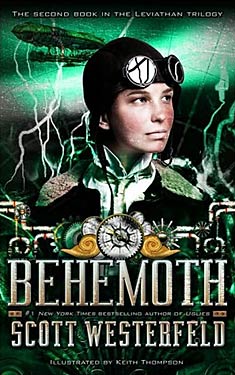 Behemoth by Scott Westerfeld
Behemoth by Scott Westerfeld
Published: Simon Pulse, 2010
Series: Leviathan Series: Book 2
Award Nominations: Locus Young Adult Award 2011
The Book:
"It is near the beginning of World War I, and the situation in Europe is spiraling out of control. After the assassination of Archduke Franz Ferdinand, battle lines have been drawn between ‘Clanker’ powers—whose technology involves mostly heavy machinery—and the ‘Darwinists’—who rely on fabricated animals. A wild card in this scenario is the Ottoman Empire, which is currently maintaining fragile neutrality. After Churchill ‘borrows’ a warship bought by the Ottomans, diplomatic relations between the Ottomans and the Darwinists begin to worsen.
It is into this situation that the Darwinist Leviathan airship soars, carrying with it the adventurous midshipman ‘Dylan’ Sharp and the fugitive Clanker aristocrat Aleksandar. Dylan and Alek have forged a close friendship, though they both hold secrets. Alek may be the heir to the Austro-Hungarian Empire, and ‘Dylan’ is actually Deryn, a young woman who has joined the military in disguise. They’re going to have to work together to navigate the dangerous cultural and political tangle of the Ottoman capital of Istanbul!” ~Allie
This is the second of my reviews for WWEnd’s YA Genre Fiction Month. (See my review for Leviathan here.) Behemoth picks up right where Leviathan left off, so it’s absolutely necessary to read the series in order. Thus far, I have been happy with the way each novel concludes its individual arc, while still continuing the overarching story of the series.
On a side note, Westerfeld takes some slightly more subtle liberties with established history in Behemoth. I could see some readers being concerned that the trilogy’s alternate history may obscure actual history for younger readers. I don’t think this will be a problem, however, as Westerfeld helpfully includes an afterword in each novel that explicitly states which parts of his story are fact and which fiction.
My Thoughts:
Behemoth continues the adventure of Leviathan, and it is brought to life by many more of Keith Thompson’s amazing illustrations like the one in the header above. While the story felt as exciting and action-packed as in Leviathan, it moves in a slightly different direction. Rather than traipsing around Europe in an organic airship, this installment focuses primarily on the situation in Istanbul, where Deryn and Alek spend a lot of time undercover. I enjoyed reading about the multicultural city of Istanbul, and the mixture of Clanker and Darwinist influences in their society. While much of the Ottoman technology could be considered Clanker, their machines tend to emulate animals or mythological beings from many cultures. Westerfeld’s Istanbul expands his vision of this world, and the city has plenty of mystery and conflict to maintain the tension and excitement of the story.
Deryn and Alek are still incredibly active and resourceful protagonists, and they continue to find themselves in very dangerous and interesting situations. However, I was a little less than thrilled with the way their inevitable romantic subplot is handled. There’s very little build-up, so it ended up feeling a little tacked on to the central story. Though Deryn’s hidden gender mixed things up a bit, it still leaned a little too heavily on common young adult romance plot devices for my taste. While it wasn’t a major focus in Behemoth, I feel fairly certain that the romance angle will continue into the third book, where I hope it will be more smoothly integrated and thoroughly developed.
In addition to Deryn and Alek, there are many notable minor characters. Two repeating characters—Alek’s fencing master, Count Volger, and the Darwinist scientist, Dr. Barlow—get a bit more development in this installment. They are the schemers on Alek’s and Deryn’s sides, respectively, and I enjoyed learning more about their plans. A new addition to the cast is the mysterious creature Dr. Barlow carried through Leviathan. The critter is certainly adorable, but I’m not altogether fond of its role in the narrative thus far. Another notable new addition is the American reporter, Eddie Malone. I was glad Westerfeld did not go the easy adventure-story route and portray him as a simple annoyance to Deryn and Alek. These and other characters are beginning to widen the world that Leviathan introduced.
 The title of the novel, Behemoth, once again has several meanings. Leviathan was a reference to gigantic whale-like airbeast, but I believe it was also a reference to Thomas Hobbes’ work of the same name. The Behemoth is the companion beast to the Darwinist warship Churchill held back from the Ottomans, and it is also the name of another work by Hobbes. In Leviathan, Hobbes described an ideal government, and in Behemoth, he described the causes and effects of revolution. Hobbes believed that no good could come from rebellion, but Alek and Deryn’s adventures don’t altogether support that final conclusion. I think the story of Behemoth provides an opportunity to discuss what circumstances, if any, justify carrying out a violent revolution.
The title of the novel, Behemoth, once again has several meanings. Leviathan was a reference to gigantic whale-like airbeast, but I believe it was also a reference to Thomas Hobbes’ work of the same name. The Behemoth is the companion beast to the Darwinist warship Churchill held back from the Ottomans, and it is also the name of another work by Hobbes. In Leviathan, Hobbes described an ideal government, and in Behemoth, he described the causes and effects of revolution. Hobbes believed that no good could come from rebellion, but Alek and Deryn’s adventures don’t altogether support that final conclusion. I think the story of Behemoth provides an opportunity to discuss what circumstances, if any, justify carrying out a violent revolution.
My Rating: 4/5
Behemoth lives up to the standard set by Leviathan. Alek and Deryn’s adventures are more stationary, and more politically based, but no less exciting. Behemoth introduces several new and interesting characters, and shows the unique culture of fictional Istanbul. I did not think the typical YA romance was integrated particularly well into the story, though I hope the romantic subplot will be developed more deftly in the third novel. Like its predecessor, Behemoth brings up some interesting topics for discussion, and it contains more depth than just the surface adventure story. Behemoth answers many of the questions left from Leviathan, but, of course, the final conclusion of the story is yet to come, in the final volume, Goliath!
YA Genre Fiction Month: Ender’s Game
“Sometimes lies were more dependable than the truth.”
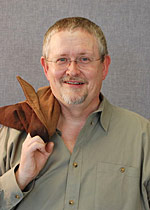 Orson Scott Card’s first story about Andrew “Ender” Wiggin has remained one of the most popular science fiction stories for young audiences ever since its publication as a novel in 1985. Considered to be one of the best Young Adult science fiction novels, Ender’s Game is far better even than Card’s own sequels to the novel. The story is simply told—a bragging point for Card in his introduction to the 1991 revised edition, against those who “play the game of literary criticism”—and its protagonist begins the story at the age of six, making the novel doubly appealing to young readers. It also presents a detailed and believable space-dwelling society, describing simply but thoroughly how life outside our planet might look.
Orson Scott Card’s first story about Andrew “Ender” Wiggin has remained one of the most popular science fiction stories for young audiences ever since its publication as a novel in 1985. Considered to be one of the best Young Adult science fiction novels, Ender’s Game is far better even than Card’s own sequels to the novel. The story is simply told—a bragging point for Card in his introduction to the 1991 revised edition, against those who “play the game of literary criticism”—and its protagonist begins the story at the age of six, making the novel doubly appealing to young readers. It also presents a detailed and believable space-dwelling society, describing simply but thoroughly how life outside our planet might look.
The story, for those who don’t know it, revolves around the ongoing war with the only known sentient alien species, termed the “buggers” because of their insectoid appearance. After the buggers’ second invasion almost wiped out Earth’s military forces, with the humans just barely pulling a victory, the government begins genetically manipulating children in the hopes of creating a military leader strong and intelligent enough to defeat the buggers once and for all. Ender is the third child of his family to be grown this way, leaving him with siblings who are exceptional, but flawed for the military’s purposes. Only Ender has the mixture of strength, genius, and compassion needed to make their plans work, so he is chosen as a mere child to begin training at the extra-terrestrial Battle School. It is there that his teachers make him into a weapon to save the Earth.
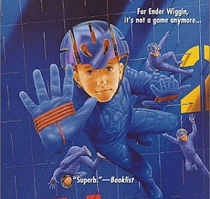 Of particular interest are Card’s predictions of future technologies that are surprisingly similar to what we see around us today. The most obvious is the anonymous method of written communication over “the nets.” Two characters in particular make careers for themselves through pseudonymous writing on the public and electronic discussion groups. The only part of this prediction that seems unrealistic today is the belief that online discussions would ever be taken seriously by politicians. The other prediction is in the immersive electronic Game played by the Battle School children in their free time. Using an avatar to travel around a three-dimensional and fantastic world, solving puzzles and fighting battles in the meanwhile, their Game might as well be a version of World of Warcraft.
Of particular interest are Card’s predictions of future technologies that are surprisingly similar to what we see around us today. The most obvious is the anonymous method of written communication over “the nets.” Two characters in particular make careers for themselves through pseudonymous writing on the public and electronic discussion groups. The only part of this prediction that seems unrealistic today is the belief that online discussions would ever be taken seriously by politicians. The other prediction is in the immersive electronic Game played by the Battle School children in their free time. Using an avatar to travel around a three-dimensional and fantastic world, solving puzzles and fighting battles in the meanwhile, their Game might as well be a version of World of Warcraft.
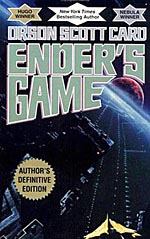 Ender’s Game is not beyond criticism. The novel’s plot feeds the natural but immature narcissism of young people by presenting a world that revolves around a brilliant young person rather than insisting on the need for young adults to assimilate themselves to the society which is much older and stronger than they are. (To be fair, this is a common problem in Young Adult novels, possibly the most common.) Even worse, it encourages a deep distrust of adults as cynical overlords who use children—the bright and perfect children—for horrible purposes. As Ender thinks to himself at one point, “The most important message was this: the adults are the enemy, not the other armies. They do not tell us the truth.” The real world provides enough tension between generations without novelists stirring up further hatred and distrust. Somewhat less annoying is Card’s blatant distaste for literary criticism and “encoded fiction,” which unfortunately serves to make the novel unmemorable aside from its plot and emotional content, as there is no reason ever to go back and enjoy any beautifully-written passages. There’s a fine line between wanting to write a straightforward story and being lazy and unimaginative.
Ender’s Game is not beyond criticism. The novel’s plot feeds the natural but immature narcissism of young people by presenting a world that revolves around a brilliant young person rather than insisting on the need for young adults to assimilate themselves to the society which is much older and stronger than they are. (To be fair, this is a common problem in Young Adult novels, possibly the most common.) Even worse, it encourages a deep distrust of adults as cynical overlords who use children—the bright and perfect children—for horrible purposes. As Ender thinks to himself at one point, “The most important message was this: the adults are the enemy, not the other armies. They do not tell us the truth.” The real world provides enough tension between generations without novelists stirring up further hatred and distrust. Somewhat less annoying is Card’s blatant distaste for literary criticism and “encoded fiction,” which unfortunately serves to make the novel unmemorable aside from its plot and emotional content, as there is no reason ever to go back and enjoy any beautifully-written passages. There’s a fine line between wanting to write a straightforward story and being lazy and unimaginative.
But despite my reservations, Ender’s Game is still one of the most memorable science fiction novels of the last few decades, and its flaws have not prevented its success. It is certainly the best of Card’s novels that I’ve read, and it was clever enough that I didn’t even suspect the twist ending until it hit me. A quick read that will never leave you bored, and might even make you think, Ender’s Game will undoubtedly remain a Young Adult genre classic for years to come.
YA Genre Fiction Month: Leviathan
Guest Blogger, Allie McCarn, reviews science fiction and fantasy books on her blog Tethyan Books which we featured in a previous post: Five SF/F Book Blogs Worth Reading. She has already contributed many great book reviews to WWEnd and has generously volunteered to write some periodic reviews for our blog. Be sure to check out her site and let her know you found her here.
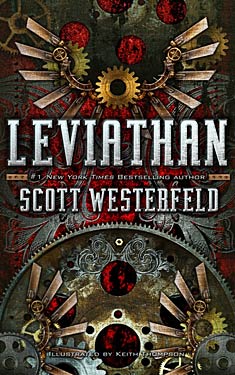 Leviathan by Scott Westerfeld
Leviathan by Scott Westerfeld
Published: Simon Pulse, 2009
Series: Leviathan Series: Book 1
Awards Won: Locus Young Adult Award 2010
The Book:
"It is the cusp of World War I. The Austro-Hungarians and Germans have their Clankers, steam-driven iron machines loaded with guns and ammunition. The British Darwinists employ genetically fabricated animals as their weaponry. Their Leviathan is a whale airship, and the most masterful beast in the British fleet.
Aleksandar Ferdinand, a Clanker, and Deryn Sharp, a Darwinist, are on opposite sides of the war. But their paths cross in the most unexpected way, taking them both aboard the Leviathan on a fantastical, around-the-world adventure…. One that will change both their lives forever." ~barnesandnoble.com
Scott Westerfeld is a well-known name in young adult fiction, though up until now I’d never read any of his work. In honor of WWEnd’s “Young Adult Genre Fiction” month, I’m reviewing his most recent series, which starts with Leviathan. Leviathan had a satisfying ending, to my mind, but it is clearly the first part of a larger story. The final volume of this series, Goliath, came out this past September, so I’m looking forward to being able to read the complete trilogy, uninterrupted!
My Thoughts:
Leviathan is a non-stop adventure that spans several European countries. While it takes place during the start of World War I, many aspects of Westerfeld’s world differ from reality. The most notable difference, of course, is the presence of fantastical technology. The Clankers have powerful, steam-powered walkers, and the Darwinists have amazing animals fabricated from the ‘life strings’ of many different species. These animals range from messenger lizards, to jellyfish-based airbeasts, to complicated floating ecosystems like the Leviathan airship of the book’s title. Westerfeld spends a lot of time describing his imaginative creations, and they are also brought to life by Keith Thompson’s many beautiful illustrations (like the example map in the header above).
While the technology is a major selling point of the story, Leviathan also features two engaging protagonists. Alek Ferdinand (yes, that Ferdinand) is an aristocratic Clanker fugitive with a huge secret. His parents made sure he was trained in mechaniks, swordfighting, and many languages, but he still has no idea how to deal with the world outside his family’s estate. Deryn Sharp has a pretty major secret of her own—she’s joined the British military as a midshipman, posing as a boy. Deryn mostly manages to keep everyone convinced of her gender through force of personality. Her never-ending exuberance and boyish swagger make it seem like her life has always been a jump from one adventure to the next. Deryn and Alek are opposites in many ways, though they are both fallible teenagers in the middle of very dangerous situations.
Though Deryn and Alek are exciting characters to follow, they seem to be written a little younger than their supposed age. If the book had not specified that they were fifteen, I would have estimated an age of twelve or thirteen. Even in the many illustrations, they appear to be shown as pre-teens, not teens. In general, I would say that is in line with the targeted demographic, which I would guess to be middle schoolers (about 12-14 years old). This guess is based on the reading level, the portrayal of the protagonists, and the amount of questionable content (very little, save for a few potentially frightening battle scenes). I don’t mean to say that someone older couldn’t enjoy it—I’m over a decade past that age group, and I still thought Leviathan was a lot of fun.
Aside from the constant thrills of the story, Leviathan is also concerned with portraying the interconnectedness of living systems. One example of this can be seen in the Leviathan airship itself. In addition to the hydrogen-filled whale-like creature that makes up its main body, the Leviathan’s life and health rely on an ecosystem made up of birds, bats, bees, bacteria, curious hydrogen-sniffing animals, and many others. If any one of the pieces of this system is missing, it will have disastrous effects on the whole.
 The Leviathan airship is also controlled by Captain Hobbes, which makes it a fairly clear reference to Thomas Hobbes’s famous work of the same name. Hobbes’s work is an early example of social contract theory, and it describes an ideal government as a kind of enormous, complex creature composed of its living members. The themes of interdependence and cooperation are also repeated in various ways through the political discussions and actions of the novel. While Leviathan is entertaining as an adventure story, there’s also plenty of discussion material for those who want to look beneath the surface.
The Leviathan airship is also controlled by Captain Hobbes, which makes it a fairly clear reference to Thomas Hobbes’s famous work of the same name. Hobbes’s work is an early example of social contract theory, and it describes an ideal government as a kind of enormous, complex creature composed of its living members. The themes of interdependence and cooperation are also repeated in various ways through the political discussions and actions of the novel. While Leviathan is entertaining as an adventure story, there’s also plenty of discussion material for those who want to look beneath the surface.
My Rating: 4/5
Leviathan is an exciting, action-packed steampunk re-imagining of World War I, with fantastic technology that is brought to life through Keith Thompson’s frequent illustrations. Though the protagonists, Alek and Deryn, seem younger than their fifteen years, they are engagingly intelligent and resourceful protagonists. Leviathan also contains a subtext about the interdependence of living systems and the necessity of cooperation, making it a book worth discussion. I’m starting Behemoth now, and I can’t wait to see what happens next!
Science Fiction for Young Adults: A Recommended List by David Brin
 As part of our YA Genre Fiction Month on WWEnd we’ve added a new list of books for your reading pleasure:
As part of our YA Genre Fiction Month on WWEnd we’ve added a new list of books for your reading pleasure:
Science Fiction for Young Adults: A Recommended List by David Brin
Why post a YA list by David Brin? Well, he’s David Brin for crying out loud – which is reason enough for me. And it’s a really good list. But mainly it because Mr. Brin has been actively working to spread the gospel of SF/F to younger fans for many years. I’ll let him explain:
For two decades I’ve been involved in projects to help engage young readers with science fiction, from the AboutSF and Reading for the Future programs to my own WoW Prize and helping establish the Andre Nortion Nebula Award for Young Adult SF. After years replying to personal queries I finally compiled my own recommended reading lists for Young Adults as well as elementary and middle school kids. I hope they prove useful. Good sci fi correlates with vigor, creativity and success, not only for young readers, but for any civilization!
Bravo, Mr. Brin. Be sure to visit the author’s blog, Contrary Brin, to read the original post of the list which contains short intros and commentary for each of the books.
So what do you think of this list? Anything you would want to add or take out? How many of these have you read? Check your reading stats to see. I’ve only read 16 out of 89 but I’ve got a half dozen more on my reading list.
YA Genre Fiction Month: Bilbo the Doughboy
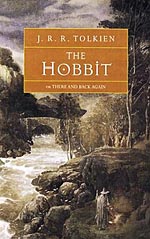 When you think of WWI fantasy, especially in the young adult genre, you might think of steampunk sci-fi, like Scott Westerfeld‘s Leviathan series. I, on the other hand, think of The Hobbit. Tolkien wrote this classic in 1937, well after the Great War, but much of it came from his experience in the trenches. The book begins with Bilbo puttering around Bag End in the idyllic setting of the Shire, not unlike Tolkien’s own neighborhood in north Oxford. He is then, quite literally drafted by Gandalf to join a platoon of dwarves and sent to the front of a war to witness the Desolation of Smaug. It’s a story similar to Tolkien’s own experience in the Great War, where he was struck with trench fever in 1916. It was while recovering from the disease that he began writing The Book of Lost Tales, which would establish the history and continuity of Middle-Earth.
When you think of WWI fantasy, especially in the young adult genre, you might think of steampunk sci-fi, like Scott Westerfeld‘s Leviathan series. I, on the other hand, think of The Hobbit. Tolkien wrote this classic in 1937, well after the Great War, but much of it came from his experience in the trenches. The book begins with Bilbo puttering around Bag End in the idyllic setting of the Shire, not unlike Tolkien’s own neighborhood in north Oxford. He is then, quite literally drafted by Gandalf to join a platoon of dwarves and sent to the front of a war to witness the Desolation of Smaug. It’s a story similar to Tolkien’s own experience in the Great War, where he was struck with trench fever in 1916. It was while recovering from the disease that he began writing The Book of Lost Tales, which would establish the history and continuity of Middle-Earth.
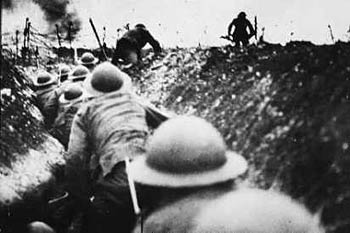 At first glance, trench warfare might not seem like a suitable inspiration for a children’s book. Perhaps that is why it took so long for The Hobbit to be written. Although set in Middle-Earth, Bilbo’s story wasn’t penned until the 1930s, when, upon spying a blank sheet of paper Tolkien impishly wrote "In a hole in the ground, there lived a hobbit." It might have been terror and illness that inspired Middle-Earth for the author, but the first published account of that world would be more childlike and innocent.
At first glance, trench warfare might not seem like a suitable inspiration for a children’s book. Perhaps that is why it took so long for The Hobbit to be written. Although set in Middle-Earth, Bilbo’s story wasn’t penned until the 1930s, when, upon spying a blank sheet of paper Tolkien impishly wrote "In a hole in the ground, there lived a hobbit." It might have been terror and illness that inspired Middle-Earth for the author, but the first published account of that world would be more childlike and innocent.
In this sense, one might say that the story of Tolkien’s world is backwards. The Book of Lost Tales was the first thing Tolkien put to paper, but it wouldn’t be published until 1992, long after the author’s death. We, the reader, would begin not in desolation, but in delight. That’s how it started for me, of course. The Hobbit was one of the first YA books I ever read (after The Chronicles of Narnia by C.S. Lewis, and Ursula K. Le Guin‘s Earthsea Trilogy). It was a great transition for me, because it was really the only YA book set in Middle-Earth. Of course, I read the entire Lord of the Rings series as a teenager, but it was really intended for adults. By the time I graduated to The Silmarillion, I was out of my element. At 14, I barely understood the mature themes and deep mythological references.
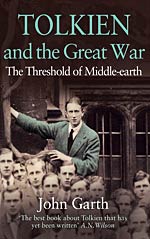 The Hobbit, then, is not just a children’s or a YA book. It’s an introduction to wider world that continues to expand in depth and complexity as its reader matures. It is, as the best of fantasy ought to be, the first in a series of books that taps into human tradition and reminds us of what we once believed…and might believe again. What does all of that have to do with a fruitless war that is universally regarded as a dark chapter in human history? Like many works of the Lost Generation, it is a reaction to the event — one that recognizes the inevitability of conflict and human misery. Unlike many of those works, however, there is more hope than mourning. Bilbo returns from his war changed, possibly less innocent, but not truly lost.
The Hobbit, then, is not just a children’s or a YA book. It’s an introduction to wider world that continues to expand in depth and complexity as its reader matures. It is, as the best of fantasy ought to be, the first in a series of books that taps into human tradition and reminds us of what we once believed…and might believe again. What does all of that have to do with a fruitless war that is universally regarded as a dark chapter in human history? Like many works of the Lost Generation, it is a reaction to the event — one that recognizes the inevitability of conflict and human misery. Unlike many of those works, however, there is more hope than mourning. Bilbo returns from his war changed, possibly less innocent, but not truly lost.
There is a reason an entire genre was inspired (perhaps overly so) by this new kind of young adult fantasy, and, as great as our current crop of writers are, I’m not entirely convinced that they have topped this classic.
YA Genre Fiction Month: The Chronicles of Narnia
It all began with a wardrobe. Being your average, American, suburban child, of course I had no idea what a wardrobe was. All I knew was that it was far larger on the inside than the outside, large enough to house a fairy kingdom of gods and talking beasts, of hidden kings and snowed in lampposts.
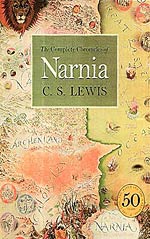 The stories of C.S. Lewis’s Narnia series are in a certain sense pretty standard fare: a child living in unappealing and banal circumstances finds a doorway to a magical realm, has many adventures in said realm, then returns to find that life in the normal world is much enriched by the experience. It would be hard to find a more prototypical plot than this. Even so, Lewis’s series manages to stand out in a crowd of similar stories, and I suspect this is because he evoked a world that is lost, but which was very much real: the Middle Ages.
The stories of C.S. Lewis’s Narnia series are in a certain sense pretty standard fare: a child living in unappealing and banal circumstances finds a doorway to a magical realm, has many adventures in said realm, then returns to find that life in the normal world is much enriched by the experience. It would be hard to find a more prototypical plot than this. Even so, Lewis’s series manages to stand out in a crowd of similar stories, and I suspect this is because he evoked a world that is lost, but which was very much real: the Middle Ages.
Being a scholar of Medieval literature by trade, Lewis was well-suited to the task of reviving a dead age. His book The Discarded Image is an introductory exploration of the way Medieval man viewed the world, which was as a subtly complex and interconnected system that hummed in a sort of clockwork harmony. It was a world rife with symbols and archetypes, with God at its source, and all his creatures working either against or with this source.
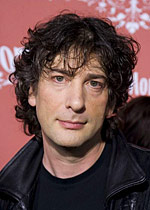 So of course modern fantasy writers hate it. Neil Gaiman and Philip Pullman are the most recent detractors, vilifying Lewis’s books as being nothing more than religious propaganda. They are not entirely wrong. Lewis was hardly ashamed of his conversion to Anglicanism, publishing many books and essays on both his conversion and the theology of his new religion. When it came to writing fiction, Anglican-Protestant theology was a motivating force, as well. His Cosmic Trilogy is clearly theological in places, especially in Perelandra, which served as a “scientifiction” reimagining of Paradise Lost on another planet. The Narnia series is even more blatantly Christian in as much as it depicts Aslan, a talking lion who is not simply a Christ-figure or an allegory, but Christ himself.
So of course modern fantasy writers hate it. Neil Gaiman and Philip Pullman are the most recent detractors, vilifying Lewis’s books as being nothing more than religious propaganda. They are not entirely wrong. Lewis was hardly ashamed of his conversion to Anglicanism, publishing many books and essays on both his conversion and the theology of his new religion. When it came to writing fiction, Anglican-Protestant theology was a motivating force, as well. His Cosmic Trilogy is clearly theological in places, especially in Perelandra, which served as a “scientifiction” reimagining of Paradise Lost on another planet. The Narnia series is even more blatantly Christian in as much as it depicts Aslan, a talking lion who is not simply a Christ-figure or an allegory, but Christ himself.
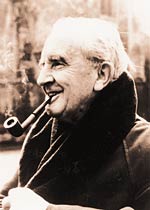 So of course Tolkien hated it. Lewis’s Catholic friend and fellow writer could only accept Lewis’s books as allegorical works because of the theological problems that would arise with a literal intention. Lewis himself published an introductory study to Medieval allegory, The Allegory of Love, and he knew his own intentions well enough to know that he was not writing an allegory. The structure of the series, and many of the characters therein, are densely symbolic (cf. Planet Narnia by Michael Ward), as is Aslan’s leonine appearance, but the character himself is controversially straightforward.
So of course Tolkien hated it. Lewis’s Catholic friend and fellow writer could only accept Lewis’s books as allegorical works because of the theological problems that would arise with a literal intention. Lewis himself published an introductory study to Medieval allegory, The Allegory of Love, and he knew his own intentions well enough to know that he was not writing an allegory. The structure of the series, and many of the characters therein, are densely symbolic (cf. Planet Narnia by Michael Ward), as is Aslan’s leonine appearance, but the character himself is controversially straightforward.
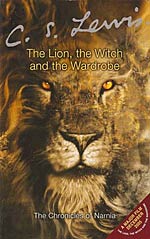 Oddly enough, none of these controversies have diminished the series’ popularity. Children and young adults everywhere continue to read them, finding inside something too often lacking in today’s literature for young people: a sense of wonder. From Mr. Tumnus’s cozy home to the Green Lady’s cavern, from the deserts of Calormen to the edge of Aslan’s country, Narnia is an unceasing flow of delightful places and events. The popularity of the recent Narnia films proves that the series has legs in the modern world. Lewis would probably be the first to insist that one should read for delight rather than duty, and even his popular detractors can’t make the books unpleasurable to read, except for unhappy adults who insist on writing and reading propaganda of the opposing sort. I think we can expect Narnia to stick around for a long time.
Oddly enough, none of these controversies have diminished the series’ popularity. Children and young adults everywhere continue to read them, finding inside something too often lacking in today’s literature for young people: a sense of wonder. From Mr. Tumnus’s cozy home to the Green Lady’s cavern, from the deserts of Calormen to the edge of Aslan’s country, Narnia is an unceasing flow of delightful places and events. The popularity of the recent Narnia films proves that the series has legs in the modern world. Lewis would probably be the first to insist that one should read for delight rather than duty, and even his popular detractors can’t make the books unpleasurable to read, except for unhappy adults who insist on writing and reading propaganda of the opposing sort. I think we can expect Narnia to stick around for a long time.
Young Adult Genre Fiction Month
It’s a new month, and time for a new theme here at Worlds Without End! During the month of October we filled in a major lacuna by including Horror as a major genre category, and by adding relevant award and book lists that show off the best of the genre. This November we’re adding and promoting a similarly popular group of fiction, which can’t quite be categorized as a genre or subgenre: Young Adult Fiction. Our more attentive members have probably noticed the addition of many Young Adult novels to the site over the last week. Doing so completes our collection of nominees for the Young Adult category of the Locus Award, and we will be publishing the full list for this award to the site soon.
To supplement the upcoming award and book lists, we will be posting Young-Adult themed book reviews and articles to the blog during the month of November. Young Adult literature stands in that precarious brink between childhood and adulthood, and the books we read during those few years often keep a special place in our memory for the rest of our lives. The books we will be featuring are likely to hold that very place for the next generation.
Few people realize (or remember) just how many Young Adult books are also examples of genre fiction. Science Fiction, Fantasy, and Horror are all well-represented in Young Adult fiction, and we at Worlds Without End wish to celebrate this representation all month, so we are dubbing November “Young Adult Genre Fiction Month.” Check back regularly for new updates and articles!



















 Full Details
Full Details
